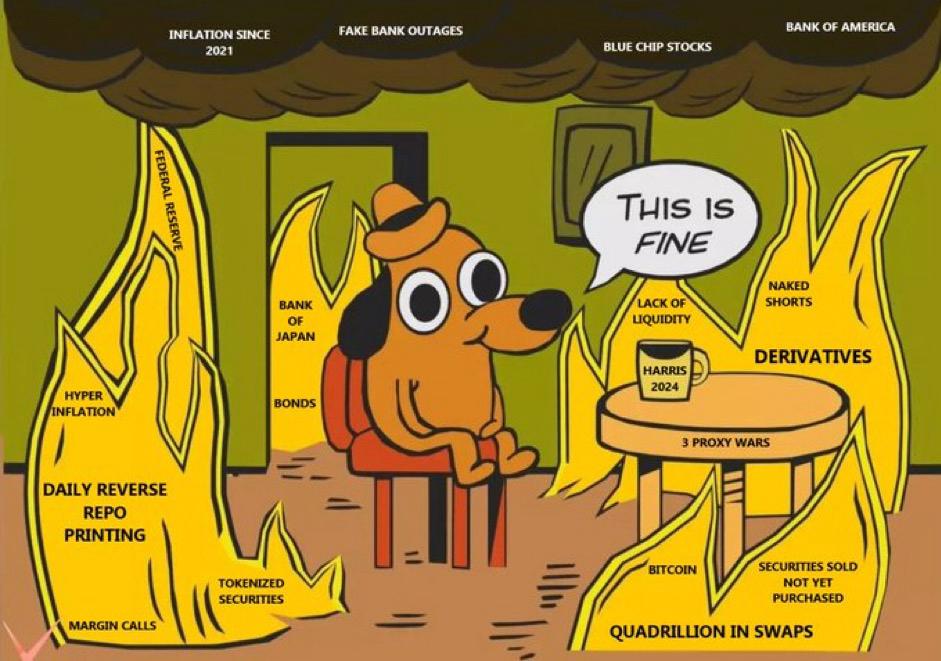
Bank of America (BAC) just released its Q1 2025 earnings, and if you thought past balance sheet shenanigans were wild, you’re in for another ride. Back in November 2024, in HOW BANK OF AMERICA IS HIDING ITS MOUNTING PROBLEMS BEHIND A MOUNTAIN OF REPURCHASE AGREEMENTS, we discussed how BAC heavily relies on repurchase agreements to maintain liquidity while its securities portfolio’s unrealized losses keep ballooning. Today, we’re diving into the latest numbers to determine whether BAC is still playing hide-and-seek with its problems or if the cracks are finally too big to conceal.
BAC’s Repo Addiction
Previously, I revealed how BAC was accumulating repurchase agreements (short-term borrowing where securities get swapped for cash with a promise to buy them back later) to boost liquidity. It’s like using a payday loan to cover your mortgage; it works until it doesn’t. In Q4 2024, BAC’s repo net balances (assets minus liabilities) were negative ~41bn$, and these balances went further negative in the current quarter to negative ~48bn$. Here’s where things become odd: while the bank reports a ~24bn$ increase in deposits from the previous quarter to almost 2 trillion $, which would suggest an increase in cash balances, in reality, BAC’s cash and equivalents continue dropping to 273bn$ in the current quarter (a drop of ~16bn$ compared to the previous quarter). Where did all the incremental ~54bn$ of cash go? BAC, which clearly didn’t learn much from its mistake in 2020, bet hard on the market by increasing the net balance of its trading assets by ~53bn$. Pretty bad timing, right? In fact, rather than strengthening its balance sheet and closing some of the deep holes around it, the bank (like amateur traders do) bet on a comeback of the bull market and on yields going lower, while the exact opposite happened. How many of these “trading assets” are going to become “hold to maturity,” so the bank can hide these losses in the next quarter too?
Known Unrealized Losses and losses hidden in the HTM books
Now for the sobering reality: BAC’s securities portfolio, particularly the held-to-maturity (HTM) book, where losses lurk like skeletons in a closet. In Q3 2024, unrealized losses reached ~131.6bn$, decreasing to ~112bn$ by Q4 as bond markets rallied. Q1 2025? The latest filings show losses in the securities book at ~100bn$. Apparently, this trend looks okay, but in yet another sign that BAC is increasing the risk in its balance sheet rather than doing the opposite, compared to December 31, 2024, the total amount of Debt Securities held by the bank increased from ~921bn$ to ~942bn$, while reducing the HTM books by only 8bn$ (likely all maturing MBS since the balance of US Treasuries remained unchanged). Why do I have a feeling that with rates now on their way back up, aligned with what I said in the previous paragraph, BAC will shift assets back into the HTM books to hide the losses that are now increasing again?
As if this figure wasn’t enough, as we discussed before in previous articles, particularly in “IS WARREN BUFFETT STARTING TO BE WORRIED ABOUT BANK OF AMERICA’S SOLVENCY?“, the fact that in the current environment the bank isn’t making meaningful provisions for expected credit losses with another mere ~1.5bn$ for the quarter (a figure that has remained roughly the same since Q1-24), is a sign that the bank is significantly underreporting the credit risk in its books that almost exclusively consider interest rate movements in the calculation of “unrealized losses”. What would be the real extent of the losses if a proper Mark to Market assessment were done on the bank? Besides 550bn$ of MBS (let’s not forget mortgage rates are currently at 7.5% while the bank bought the vast majority of these assets when they were ~3%, hence the ~80bn$ of unrealized losses they report here is an insult to the basics of fixed income assets pricing), the bank also has a 1.1 trillion$ loan book that keeps expanding quarter after quarter, indicating the bank is adding risk to its balance sheet rather than preparing for an eventual economic downturn.
Considering that the bank has ~250bn$ of reported regulatory capital and ~100bn$ are already the unrealized losses it reports, and the bank has only set aside a ~14bn$ allowance for credit losses against 3.3 trillion$ of balance sheet (yes, just 0.42%), what are the chances BAC is already insolvent if its books are marked to market properly? Perhaps Warren Buffett did the math, which is why he has been dumping his BAC shares as fast as possible, trying not to crash the price and not to alarm the large number of investors out there who are still deep asleep.
Conclusion
Bank of America’s Q1 2025 earnings are, as usual, trying to impress the media with headline profits and trading revenues beating (low ball) Wall Street expectations; however, once again, the reality is quite different beyond the smoke and mirrors set up by the bank. The repo strategy indicates short-term desperation, and those HTM losses won’t disappear without either a miracle or a major balance sheet overhaul. Both alternatives are less and less probable. What does have a higher chance of happening is what I discussed in my latest podcast “HOW THE FED FELL INTO A CHECKMATE TRAP” with BAC being one of those banks most in need of a BTFP 2.0 to relieve them from mounting liquidity pressures and the risk of being forced to liquidate assets in the market at a steep loss that can bring them straight to bankruptcy.
JustDario on X | JustDario on Instagram | JustDario on YouTube
